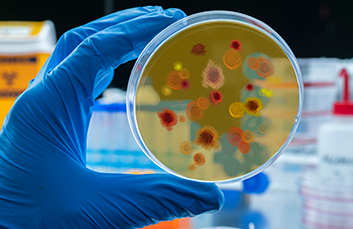A link between AMR and COVID-19
Topics Featured
Several recent publications and communications from infectious disease experts have illustrated what has been called the hidden threat behind COVID-19: antibiotic resistance.

Antibiotic resistance – the ability of bacteria to adapt to the presence of increasingly powerful, targeted antibiotics, with different mechanisms of action, and evolve resistant sub-populations – is the infectious disease crisis that has had the attention of the world for several decades. Over-prescription and overuse of antibiotics in the food production industry has exacerbated these trends. As antimicrobial treatments have become less and less effective, judicious, measured use of these drug treatments in the clinical setting has extended their usefulness.
For the last several months, the COVID-19 virus has been at the center of a new infectious disease crisis. COVID-19 is a respiratory infection that is highly transmissible and lethal, especially to those who have underlying health issues such as COPD, obesity and diabetes.
In a recently published opinion piece, Julie Gerberding, Director of the Centers for Disease Control and Prevention from 2002 to 2009, recalled concerns about antibiotic resistance complicating the treatment of SARS patients in 2003. She notes that antibiotic resistance has become much more widespread and deadly in 2020 than in 2003, with some studies finding that 1 in 7 hospitalized COVID-19 patients acquiring secondary bacterial infections that, when combined, have a 50% mortality rate. She notes that even before the COVID-19 pandemic started, the United States saw 2.8 million antibiotic resistant infections and 35,000 resulting deaths annually. This severe, highly contagious respiratory virus requiring the treatment of tens of thousands of patients in the medical facilities in which resistant bacterial infections thrive can result in disastrous consequences for all patients in those facilities.
Dr. Muhammad Zaman of Boston University and author of the book Biography of Resistance: The Epic Battle Between People and Pathogens, noted in an interview with National Public Radio that antibiotic resistance has been a part of the planetary ecosystem for millions of years. The majority of our current antibiotics originated from other bacteria that naturally produced these agents to gain an evolutionary advantage over their competition. Pharmaceuticals derived from these naturally occurring compounds constitute most of our weapons against bacterial infection. But today, over-prescription, overuse in the agricultural sector and the prevalence of counterfeit antibiotics has greatly reduced their effectiveness to a wide range of bacterial infections.
Dr. Zaman illustrated the concerns of simultaneous secondary bacterial infections reducing the ability of patients infected with respiratory viruses to recover, pointing to the history of the great flu pandemic of 1918 in which the majority of the deaths occurred because of pneumonia caused by the bacteria, and not the virus itself. Although he notes that it is not possible at this time to definitively link secondary bacterial infections to the high mortality of COVID-19, correspondence published in the Lancet point to that possibility, especially when considering the standard of care for COVID-19 patients placed in the ICU, usually the administration of broad spectrum antibiotics initially, until susceptibility testing is performed and antibiotic de-escalation can begin.
In the era of COVID-19, faster and more definitive genetic detection of AMR is warranted to screen the ICU, other patient treatment areas and equipment for the proper care of these patients and to encourage the efficient use of antibiotics.
To help combat the spread of antimicrobial resistance, we developed Streck ARM-D® Kits. The kits provide a rapid molecular detection strategy for monitoring β-lactamase antibiotic resistance to improve surveillance, aid antibiotic stewardship programs and support infection control programs. These comprehensive real-time PCR kits test for the presence of genes encoding carbapenamases, extended-spectrum β-lactamases, plasmid-mediated ampCs and other emerging threats.
For information about our comprehensive line of antibiotic resistance detection kits and to browse webinars, talks and posters related to antimicrobial resistance, visit our resources page.
Streck ARM-D Kits are for Research Use Only. Not for use in diagnostic procedures.


New antibiotic fights antimicrobial resistant bacteria

